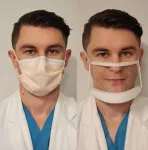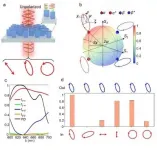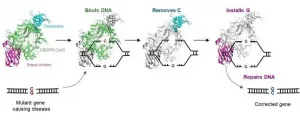In two new studies published today in Cancer Cell, researchers from Dana-Farber Cancer Institute and the Broad Institute of MIT and Harvard used the emerging technology of single-cell RNA sequencing to draw a clearer picture of how kidney tumors' microenvironments change in response to immunotherapy. The researchers believe that this work points to potential targets for new drug therapies.
"We have a standard of care for treating kidney cancer patients, but many patients do not respond to existing therapies, and we need to discover new targets," said Eliezer Van Allen, MD, an oncologist at Dana-Farber, associate professor of medicine at Harvard Medical School, associate member at the Broad Institute, and co-senior author on one of the papers.
"These companion studies shed important new light on the biology of advanced kidney tumors and their surrounding environments. With this increased understanding, researchers will be able to identify new potential drug treatment targets and, overall, expand the number of patients who can receive effective treatment," remarked Catherine J. Wu, MD, chief of the Division of Stem Cell Transplantation and Cellular Therapies at Dana-Farber, professor of medicine at Harvard Medical School, an institute member at the Broad, and co-senior author on one of the papers.
"A patient's immune system plays a critical role in controlling both the progression of cancer and the response to immune therapies," adds Toni K. Choueiri, MD director of the Lank Center for Genitourinary Oncology at Dana-Farber, an associate member at the Broad, and the Jerome and Nancy Kohlberg Professor of Medicine at Harvard Medical School. Choueiri is co-senior author on both papers. "We don't quite know why some tumors respond and some don't. We also don't know why kidney cancers become resistant to immunotherapy. These two studies are a large team effort to give us a sharper image of what happens on not just the cellular level but down to the RNA of each of those cells."
With immunotherapy, patients are typically given an immune checkpoint blockade (ICB) (often in combination with VEGF tyrosine kinase inhibitors; TKIs). The drugs are designed to stop the immune system from stopping itself, thus allowing it to attack the tumor like any other unwanted pathogen. However, immunotherapy is only successful in about half of ccRCC patients, and almost all patients build resistance to the treatment over time.
About 76,000 Americans are diagnosed with kidney cancer in the U.S. each year, which is also responsible for more than 13,000 deaths annually, according to the American Cancer Society.
Finding new targets to disrupt an immune dysfunction circuit In one study, researchers performed single-cell RNA and T cell receptor sequencing on 164,722 individual cells from tumor and adjacent non-tumor tissue. These samples came from 13 patients with clear cell renal cell carcinoma (ccRCC), which make up 80 percent of kidney cancer cases, at different stages of disease: early, locally advanced and advanced/metastatic.
In most solid tumors, the presence of a specific type of immune cell, the CD8+ T cell is a good thing. Their presence shows the immune system is working. However, researchers found that in advanced stage disease these CD8+ T cells were "exhausted," and not able to carry out their usual function.
They also discovered more anti-inflammatory or "M2-like" macrophages, a type of white blood cell that suppresses the immune system, in advanced stage disease. CD8+ T cells and macrophages were playing off each other and caught in an "immune dysfunction circuit," said co-lead author David A. Braun, MD, PhD, an oncologist at Dana-Farber and instructor of medicine at Harvard Medical School. In advanced disease samples, macrophages produce molecules that support CD8+ T cell exhaustion, at the same time those CD8+ T cells make molecules that supported the life of pro-tumor macrophages.
These findings are important because they "open up a whole new landscape of potential treatment targets," said Braun. "We already target some of the immune system pathways in kidney cancer, but our work uncovered many other immune inhibitory pathways supporting cell dysfunction. As we move forward, we can look at all of these interactions and identify new opportunities to disrupt the circuit, with the goal of restoring the immune system's anti-tumor effect and ultimately improving outcomes for patients with kidney cancer."
Choueiri and Wu are co-senior authors on the study, "Progressive immune dysfunction with advancing disease stage in renal cell carcinomas."
Identifying treatments beyond the PD-1/PD-L1 axis The other study published today looks at tumor and immune reprogramming during immunotherapy in ccRCC.
Most current immunotherapy treatments for ccRCC target the PD-1/PD-L1 axis, a pathway that makes proteins that halt the immune system from attacking cancer cells. Stop the stoppers, and the immune system can go after cancer cells.
But these drugs are only effective in half of ccRCC patients, and almost all patients eventually develop resistance to the drug.
"There may be immune evasion mechanisms outside of PD-1/PD-L1 that play an important role in response or resistance," said Kevin Bi, computational biologist at Dana-Farber and co-lead author on the paper.
Researchers used single-cell RNA sequencing to look 34,326 total cells drawn from samples from eight patients, seven of whom had metastatic renal cancer and one with localized disease. Five samples were from patients who had already received treatment, either through ICB, or a combination of ICB and TKI. Those treated with ICB were all given drugs that specifically targeted the PD-1/PD-L1 axis.
Researchers found that ICB remodels the cancer microenvironment and changes how cancer and immune cells interact, in a few ways:
In patients whose cancer responded to treatment, subsets of cytotoxic T-cells, which are cancer-fighting lymphocytes, express higher levels of co-inhibitory receptors and effector molecules. Macrophages from treated biopsies shift towards pro-inflammatory states in response to an interferon-rich microenvironment but also upregulate immunosuppressive markers. In cancer cells treated with ICB, researchers found two subpopulations, differing in angiogenic signaling and upregulation of immunosuppressive programs. In advance stage cancers treated with ICB, expression signatures for cancer cell subpopulations and immune evasion were associated with the PBRM1 mutation, the second most commonly mutated gene in ccRCC.
These findings show the importance of exploring immune pathways away from the PD-1/PD-L1 axis, said Meng Xiao He, a graduate student in the Harvard Biophysics program, member of the Van Allen lab at Dana-Farber, and a co-lead author on the paper.
"We need to look at things that are not just CD8+ T cells. We should look at macrophages, some of the other immune checkpoints, and assess what may be targetable," he said. "We're still in the early days of trying to understand the mechanisms of immunotherapy resistance in different diseases. There's a lot of room to keep trying so that more people respond, and those responses hold."
Choueiri and Van Allen are co-senior authors on the study, "Tumor and immune reprogramming during immunotherapy in advance renal cell carcinoma."
INFORMATION:
The co-authors of "Progressive immune dysfunction with advancing disease stage in renal cell carcinomas" are Kelly Street, PhD, of Dana-Farber and the Harvard T.H. Chan School of Public Health; Kelly P. Burke, MD, PhD, Dana-Farber and Harvard Medical School; David L. Cookmeyer, of Harvard Medical School; Thomas Denize, MD of Harvard Medical School and Brigham and Women's Hospital (BWH); Christina B. Pedersen, of Technical University of Denmark, Rigshospitalet-Copenhagen University Hospital; Satyen H. Gohil, PhD, of Dana-Farber, Harvard Medical School, the Broad Institute and University College, London; Nicholas Schindler, BSE, of Dana-Farber; Lucas Pomerance, BA of Dana-Farber and Harvard Medical School; Lauren Hirsch, MD, of Dana-Farber and Harvard Medical School; Ziad Bakouny, MD, of Dana-Farber; Yue Hou, PhD, of Dana-Farber; Juliet Forman, of Dana-Farber and the Broad Institute; Teddy Huang, PhD of Dana-Farber; Shuqiang Li, PhD, of Dana-Farber and Harvard Medical School; Ang Cui, MS, of the Broad Institute and Harvard-MIT Division of Health Sciences and Technology; Derin B. Keskin, PhD, of Dana-Farber and the Broad Institute; John Steinharter, MS, of Dana-Farber; Gabrielle Bouchard, BS, of Dana-Farber; Maxine Sun, PhD, MPH, of Dana-Farber; Erica M. Pimenta, MD, PhD, of Dana-Farber and Harvard Medical School; Wenxin Xu, MD of Dana-Farber and Harvard Medical School; Kathleen M. Mahoney, MD, PhD, of Dana-Farber, Harvard Medical School and Beth Israel Deaconess Medical Center; Bradley A. McGregor, MD, of Dana-Farber and Harvard Medical School; Michelle S. Hirsch, MD, PhD, of Harvard Medical School and BWH; Steven L. Chang, MD, of Harvard Medical School and BWH; Kenneth J. Livak, PhD, of Dana-Farber; David F. McDermott, MD, of Harvard Medical School and Beth Israel Deaconess Medical Center; Sachet A. Shukla, PhD, of the Broad Institute and Dana-Farber; Lars R. Olsen, PhD of Technical University of Denmark, Center for Genomic Medicine, Rigshospitalet; Sabina Signoretti, MD, of Harvard Medical School, BWH and Dana-Farber; Arlene H. Sharpe, MD, PhD, of the Broad Institute, Harvard Medical School and BWH; Rafael A. Irizarry, PhD, of Dana-Farber and Harvard T.H. Chan School of Public Health.
Financial support was provided Dana-Farber/Harvard Cancer Center Kidney Cancer Specialized Program of Research Excellence (grants P50CA101942-12 and P50CA101942); Dana-Farber/Harvard Cancer Center Kidney Cancer Specialized Program of Research Excellence Career Enhancement Program (grants P50CA101942-15 and P50CA101942), Department of Defense Congressionally Directed Medical Research Programs (grants KC170216 and KC190130); Department of Defense Academy of Kidney Cancer Investigators (grant KC190128), National Institute of General Medical Sciences (grants 5R35GM131802 and 5R01GM083084), National Human Genome Research Institute ENCODE Data Analysis Center (grant 5R01HG009446), Independent Research Fund Denmark (grant 8048-00078B), Kay Kendall Leukemia Fund Fellowship, Foundation de France during her post-doctoral, Bristol-Myers Squibb, Genentech, National Cancer Institute Research Specialist Award (grant R50CA251956), National Cancer Institute (grants R21 CA216772-01A1 and NCI-SPORE-2P50CA101942-11A1), ASCO Conquer Cancer Foundation Young Investigator Award; National Cancer Institute (grant R50RCA211482); National Human Genome Research Institute (grant R35GM131802), Cancer Center Support Grant (P30CA006516), Kohlberg Chair at Harvard Medical School, Trust Family, Michael Brigham, and Loker Pinard Funds for Kidney Cancer Research at Dana-Farber; National Institute of Health (grants NCI-1RO1CA155010 and NIH/NCI U24 CA224331); G. Harold and Leila Y. Mathers Foundation and the Parker Institute for Cancer Immunotherapy.
The co-authors of "Tumor and immune reprogramming during immunotherapy in advance renal cell carcinoma" are Ziad Bakouny, MD, of Dana Farber; Abhay Kanodia, Sara Napolitano, Jingyi Wu, and Grace Grimaldi, BS, of Dana-Farber and the Broad Institute; David A. Braun, MD, PhD, of Dana-Farber, the Broad Institute and Harvard Medical School; Michael S. Cuoco, BS, of the Broad Institute; Angie Mayorga, BA, of Dana-Farber; Laura DelloStritto, MPH, of Dana-Farber and the Broad Institute; Gabrielle Bouchard, BS, of Dana-Farber; John Steinharter, MS, of Dana-Farber; Alok K. Tewari, MD, PhD, of Dana-Farber and Harvard Medical School; Natalie I. Vokes, MD, of Dana-Farber and the Broad Institute; Erin Shannon, BS, of the Broad Institute; Maxine Sun, PhD, MPH of Dana-Farber; Jihye Park, PhD, of Dana-Farber and the Broad Institute; Steven L. Chang, MD, of BWH; Bradley A. McGregor, MD, of Dana-Farber; Rizwan Haq, MD, PhD of Dana-Farber and the Broad Institute; Thomas Denize, MD, of Harvard Medical School and BWH; Sabina Signoretti, MD, of Harvard Medical School, BWH and Dana-Farber; Jennifer L. Guerriero, PhD, of Harvard Medical School and Dana-Farber; Sébastien Vigneau, PhD, of Dana-Farber and the Broad Institute; Orit Rozenblatt-Rosen, PhD, of the Broad Institute; Asaf Rotem, PhD, of Dana-Farber and the Broad Institute; Aviv Regev, PhD, of Genentech.
Financial support was provided by the National Institutes of Health (grants U01 CA233100, R01 CA227388, U2C CA233195, T32 GM008313, T32 CA009172); the National Science Foundation (grant GRFP DGE1144152), Novartis-DDP grant, Kure It-AACR grant, Dunkin' Donuts Breakthrough Grant, Dana-Farber/Harvard Cancer Center Kidney Cancer Specialized Program of Research Excellence (grant P50CA101942-15; Department of Defense Congressionally Directed Medical Research Programs (grants KC170216 and KC190130), Department of Defense Academy of Kidney Cancer Investigators (grant KC190128), Kohlberg Chair at Harvard Medical School and the Trust Family, Michael Brigham, and Loker Pinard Funds for Kidney Cancer Research at Dana-Farber.
About Dana-Farber Cancer Institute
Dana-Farber Cancer Institute is one of the world's leading centers of cancer research and treatment. Dana-Farber's mission is to reduce the burden of cancer through scientific inquiry, clinical care, education, community engagement, and advocacy. We provide the latest treatments in cancer for adults through Dana-Farber/Brigham and Women's Cancer Center and for children through Dana-Farber/Boston Children's Cancer and Blood Disorders Center. Dana-Farber is the only hospital nationwide with a top 10 U.S. News & World Report Best Cancer Hospital ranking in both adult and pediatric care.
As a global leader in oncology, Dana-Farber is dedicated to a unique and equal balance between cancer research and care, translating the results of discovery into new treatments for patients locally and around the world, offering more than 1,100 clinical trials.
This press release covers two companion studies.
Additional DOI:
10.1016/j.ccell.2021.02.015







